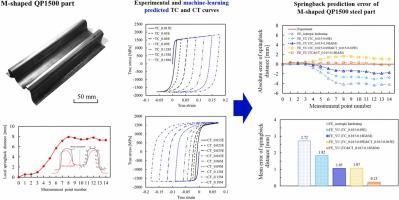Journal of Materials Processing Technology ( IF 6.7 ) Pub Date : 2022-07-29 , DOI: 10.1016/j.jmatprotec.2022.117737 Zhang Liu , Yong Hou , Rui He , You Ye , Chao Niu , Junying Min

|
Quenching and partitioning (QP) steels exhibit apparent tension-compression asymmetry and evolving Bauschinger effect as plastic deformation proceeds, which brings challenges to accurately predict springback of QP steel parts. Loading-reverse loading tests are conducted to characterize the Bauschinger effect of a QP steel with a strength grade of 1500 MPa (QP1500), where the maximum achievable strains are limited. A machine-learning method is developed to extend the capability limit of physical tension-compression (TC) or compression-tension (CT) tests and virtually generate stress vs. strain curves at larger strains (up to 0.18), which cover the strain history of an actual forming part (e.g. M-shaped part). Then a data-driven method is proposed to calibrate parameters of a kinematic hardening model (Yoshida-Uemori model), which adopts all TC and CT stress vs. strain curves from physical tests and machine learning. This new set of Yoshida-Uemori model parameters is used in finite element simulations to predict springback of an M-shaped QP1500 steel part, and an obviously improved agreement is reached between simulation and experimental measurements of the M-shaped part. The mean error of predicted local springback distance was reduced to 0.23 mm. It is demonstrated that machine learning method is capable to capture the asymmetric and evolving Bauschinger effect within a much broader strain range and improve springback prediction of QP1500 steel.
中文翻译:

机器学习用于扩展机械特性的能力,以改进淬火和分区钢的回弹预测
随着塑性变形的进行,淬火和分区 (QP) 钢表现出明显的拉伸-压缩不对称性和不断演变的包辛格效应,这给准确预测 QP 钢零件的回弹带来了挑战。进行加载-反向加载试验以表征强度等级为 1500 MPa (QP1500) 的 QP 钢的包辛格效应,其中最大可达到的应变是有限的。开发了一种机器学习方法来扩展物理拉伸-压缩 (TC) 或压缩-拉伸 (CT) 测试的能力极限,并在较大应变(高达 0.18)下虚拟生成应力与应变曲线,涵盖应变历史实际成型零件(例如 M 形零件)的形状。然后提出了一种数据驱动的方法来校准运动硬化模型(Yoshida-Uemori模型)的参数,它采用了来自物理测试和机器学习的所有 TC 和 CT 应力与应变曲线。这组新的 Yoshida-Uemori 模型参数用于有限元模拟来预测 M 形 QP1500 钢零件的回弹,并且在 M 形零件的模拟和实验测量之间达成了明显改进的一致性。预测的局部回弹距离的平均误差降低到 0.23 mm。事实证明,机器学习方法能够在更广泛的应变范围内捕捉不对称和不断变化的包辛格效应,并改善 QP1500 钢的回弹预测。M 形零件的模拟和实验测量结果之间的一致性明显提高。预测的局部回弹距离的平均误差降低到 0.23 mm。证明机器学习方法能够在更宽的应变范围内捕捉不对称和不断变化的包辛格效应,并改善 QP1500 钢的回弹预测。M 形零件的模拟和实验测量结果之间的一致性明显提高。预测的局部回弹距离的平均误差降低到 0.23 mm。证明机器学习方法能够在更宽的应变范围内捕捉不对称和不断变化的包辛格效应,并改善 QP1500 钢的回弹预测。











































 京公网安备 11010802027423号
京公网安备 11010802027423号